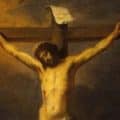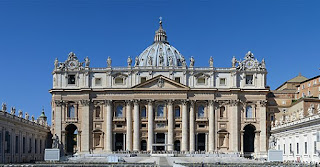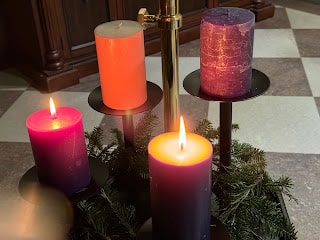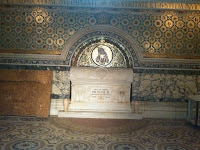Among the many wonderful things which one can watch on YouTube, there is a series of videos from the Italian TV coverage of the coronation of Pope Saint John XXIII on November 4, 1958. (TV was still somewhat new then, and that showed in the comparatively unself-conscious way the ceremony unfolded. Today, everything would be more carefully and artificially choreographed. Everyone on screen would appear exactly where he is supposed to be, when and only when he is supposed to be there, doing exactly what he is supposed to do, with nobody else in the TV frame.)
Anyway, several times during that lengthy ceremony, the Choir chants Jesus’ words which we just heard in today’s Gospel: Tu es Petrus, et super hanc petram aedificabo ecclesiam meam (“You are Peter, and upon this rock I will build my church”). Also, that Gospel account was chanted, not once but twice – first by a Latin deacon, and then by a Greek deacon. I think that’s what called making a point!
Today’s Gospel takes us back in time – from the baroque splendor of St. Peter’s Basilica and the modern papacy to the region of Caesarea Philippi and to Peter himself. Caesarea Philippi was situated some 20 miles north of the Sea of Galilee in territory ruled by King Herod’s son Philip, hence the name. That place is now known as « Banias, » a deformation of its pre-Roman name, « Paneas, » referring to the Greek god Pan. At the time of Jesus, a fertility cult was thriving in the pagan temple to Pan at this location at Israel’s northern border at the foot of Mount Hermon. That border was obviously a lot easier to cross then, in Jesus’ time, than it is now; but it was still a border, laden with symbolic spiritual significance.
The place had been a place of worship for Pan since the third century BC, with a temple built there somewhere around 20 BC. Not only was this a place probably devoted to the most literal pagan forms of nature-worship, but it also was a place that, even earlier, was probably a focus of Canaanite Baal worship.
It was to that faraway, pagan place that Jesus took his disciples and challenged them with what is, in some sense, still the basic Christian question: Who do you say that Jesus is? As befits the prominent role he is being prepared for, Peter answers on behalf of the disciples – on behalf of the entire Church: You are the Christ [the Messiah, the Anointed One], the Son of the living God. Not only does Peter proclaim that Jesus is Israel’s hoped-for Messiah, but – in that site sacred to Pan, the son of Zeus – he proclaims Jesus as the Son of the living (that is, the one true) God.
Then, as now, Peter speaks for the Church – not just for his fellow apostles, but for all of us. In response, Jesus assures us that Peter’s profession of faith is not some mere human opinion, one option among many in the global religious marketplace, but a revelation from God – one which Peter himself, at that stage, still probably at best only poorly understood. From such a modest beginning in such an oddly out-of-the-way place, Peter’s profession of who Jesus is, has been the center of the Church’s proclamation – as Peter’s role has since likewise remained central to the Church’s identity and mission.
Fast forward to the baroque basilica built above Peter’s tomb, where, for centuries since, Peter has continued to speak – on behalf of the Church for the sake of the whole world. In a Church that now, as so often in her past, seems much more divided than united, Peter serves as the visible source of the unity of the Church across space and time. Across space, “people of every nation, culture, and tongue” (as we say in the Eucharistic Prayer) are “gathered as one,” so that “in a world torn by strife and discord,” we “may stand forth,” as a Universal Church, “as a sign of oneness and peace.” Such a unity across space is, in turn, uniquely possible because of the Church’s unity across time – our unity with Peter in his profession of faith in the Christ, the Son of the living God, whose own victory over death has definitively guaranteed that the gates of the netherworld shall not prevail against the Church.
In this conflicted era of disunity and discord, when people frequently form their religion to fit their politics rather than the other way around, our unity across time in professing the ancient apostolic faith of Peter, makes possible our present unity across space as Christ’s Church in our world, which in turn fosters – for both the Church and the world – our future hope for both space and time in the kingdom of heaven.





